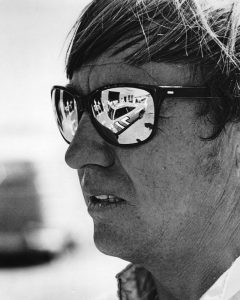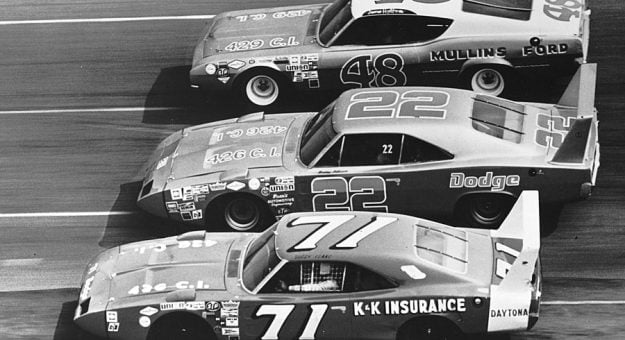Editor’s Note: NASCAR is celebrating its 75th anniversary in 2023. SPEED SPORT was founded in 1934 and was already on its way to becoming America’s Motorsports Authority when NASCAR was formed. As a result, we will bring you Part 23 of a 75-part series on the history of NASCAR as told in the pages of National Speed Sport News and SPEED SPORT Magazine.
To coin a new motorsports cliche: if you can’t pay the cash, get out of the dash.
Ford Motor Co. did just that in 1970, a year of transition for NASCAR’s Grand National circuit.
Ford Vice President Matthew S. McLaughlin’s announcement of Ford’s “withdrawal from all forms of racing” in the Nov. 25 NSSN was not unexpected. Earlier in the year the Feb. 18 edition asked, “Will (the) factories quit after (the) Daytona 500” The answer was no, but Ford continued the drastic racing cutbacks which reduced its 1970 investment to $2 million from a high of $12 million in 1967.
Ford’s new approach was to allow most Ford drivers to run as independents with a minimum of cars, parts and working capital from the manufacturer. This included $2,000 per race for pit passes and crew members, $15,000 for the year for public relations work and a 50/50 split of the purse between the team and the driver.
Ford encouraged the teams to seek outside sponsorship.
However, unconfirmed reports said the top three Ford teams were given more assistance. The Wood Brothers (Cale Yarborough’s car builder and owner), Junior Johnson (Lee Roy Yarbrough) and Holman-Moody (David Pearson) teams were each reportedly given an additional $60,000 parts-and-engine allowance for the season.
The further cutbacks hurt all the Ford teams, but crippled some. Even with more assistance than most drivers were receiving, Yarborough, Yarbrough, Pearson and Donnie Allison felt they would have to miss races because of a lack of money.
“I can’t afford to run and spend my own money,” said Allison’s crew chief Edwin (Banjo) Matthews in the March 4 NSSN. “I am in the market for anyone who wants to put his name on the side of my cars since Ford has decided to cut expenditures.”
One month later, Junior Johnson announced he was dissolving his race team, which won $188,605 in 1969, because “it’s just too expensive” to race without full factory backing.
Johnson added this caveat: “Some guys (other race teams) are going to wake up in a couple of months owing people money they don’t have.” The former Grand National driver later amended his decision and decided to run a limited number of races in 1970.
Sales & Rule Changes Dictate Manufacturer Involvement
As was always the case in Ford and Chrysler’s relationship with auto racing, new-car sales and changes in NASCAR rules played a major role in determining how deeply they were involved in the sport.

Sales were down for Ford and, despite 304 NASCAR victories and seven straight manufacturer titles from 1963-’69, this fact played a role m the company’s decision.
Yet, when the Automobile Competition Committee of the United States — racing’s governing body — upped production of Grand National-eligible cars to one car for every two auto dealerships in the U.S. in 1970 and NASCAR reduced engine sizes for 1971 to 366 cubic inches, Ford decided to withdraw from racing.
“Bobby (Isaac) can get every ounce of speed out of our car,” commented Isaac’s crew chief, Harry Hyde, on the secret behind the Catawba, N.C., native’s success in 1970.
Isaac piloted the K&K Insurance Dodge Daytona to 11 victories in 47 starts. Notably, all of Isaac’s victories came on tracks under one-mile, where he had excelled throughout his nine-year NASCAR career. Among his crowns were victories on the half-mile Beltsville, Md., circuit, the Martinsville, Va., .525-mile oval and the Columbia, S.C., half-mile dirt track.
Isaac also started from the pole 13 times and finished in the top 10 on 35 occasions. To celebrate his first Grand National championship, he set a closed-course speed record by turning a 201.104 mph lap Nov. 24 at Talladega in a special speed run.
Bobby Allison raced near Isaac’s bumper for much of the season and finished second in the points race after 15 second-place finishes and three triumphs. The driver of the red-and-gold No. 22 Dodge added 35 top-10s to his accomplishments this season.
Petty Sidelined With Injuries, Finishes Fourth
Richard Petty ended the year in fourth behind his former comrade-in-cars, Ford pilot James Hylton, who triumphed for the first time in his 10-year Grand National career in 1970. Petty’s drive for a third championship with a Chrysler went off track after a serious crash in the Rebel 400 in Darlington, S.C., sidelined him for five races with facial and neck lacerations and a dislocated shoulder.
Yet, behind the wheel of either a 1970 Plymouth Superbird or Road Runner, Petty led all drivers with 18 victories.
In NASCAR’s other divisions, Ray Elder reigned as the Pacific Coast Late Model champion while Red Farmer earned the late model sportsman crown Tiny Lund became the Grand American champ while Bugs Stevens was the modified titlist. Dick Brooks rode three top-five finishes to rookie-of-the-year honors.
With Ford’s pullout official at the end of the 1970 Grand National season and Chrysler’s withdrawal expected, Bill France remained upbeat. He predicted super-rich factory-backed teams dominating the Grand National circuit, but the question remained: how were teams like Johnson’s and Matthews’s going to compete without outside funding?
Enter the R. J. Reynolds Tobacco Co. Laden with advertising dollars after a ban on cigarette commercials on television, the maker of Winston cigarettes needed another vehicle to reach the public. So, RJR became the primary sponsor of the new NASCAR Winston Cup Series on Dec. 10 and agreed to put $100,000 into the point fund.
Under the agreement, the Talladega 500 became the Winston 500.
RJR’s introduction into its growing lineup sponsors, along with the Miller and Falstaff Brewing Companies and the STP Corp., brought NASCAR to the start of a new era.
